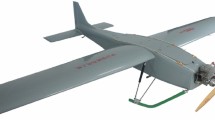Abstract
This paper describes a methodology to extract aerial vehicles’ aerodynamic characteristics from visually tracked trajectory data. The technique is being developed to study the aerodynamics of centimeter-scale aircraft and develop flight simulation models. Centimeter-scale aircraft remains a largely unstudied domain of aerodynamics, for which traditional techniques like wind tunnels and computational fluid dynamics have not yet been fully adapted and validated. The methodology takes advantage of recent progress in commercial, vision-based, motion-tracking systems. This system dispenses from on-board navigation sensors and enables indoor flight testing under controlled atmospheric conditions. Given the configuration of retro-reflective markers affixed onto the aerial vehicle, the vehicle’s six degrees-of-freedom motion can be determined in real time. Under disturbance-free conditions, the aerodynamic forces and moments can be determined from the vehicle’s inertial acceleration, and furthermore, for a fixed-wing vehicle, the aerodynamic angles can be plotted from the vehicle’s kinematics. By combining this information, we can determine the temporal evolution of the aerodynamic coefficients, as they change throughout a trajectory. An attractive feature of this technique is that trajectories are not limited to equilibrium conditions but can include non-equilibrium, maneuvering flight. Whereas in traditional wind-tunnel experiments, the operating conditions are set by the experimenter, here, the aerodynamic conditions are driven by the vehicle’s own dynamics. As a result, this methodology could be useful for characterizing the unsteady aerodynamics effects and their coupling with the aircraft flight dynamics, providing insight into aerodynamic phenomena taking place at centimeter scale flight.


















Similar content being viewed by others
References
Albertani R, Stanford B, Hubner J, Ifju P (2007) Aerodynamic coefficients and deformation measurements on flexible micro air vehicle wings. Exp Mech 47:625–635
Bevington P (2002) Data reduction and error analysis for the physical sciences, 3rd edn. McGraw-Hill Science
Brockwell P, Davis R (2006) Time series: theory and methods, 2nd edn. Springer, New York
Burk SCW Jr (1975) Radio-controlled model design and testing techniques for stall/spin evaluation of general-aviation aircraft. National Business Aircraft Meeting
Dickinson M, Gotz K (1996) The wake dynamics and flight forces of the fruit fly Drosophila melanogaster
el Hak MG (2001) Micro-air-vehicles: can they be controlled better? J Aircr 38(3):419–429
John D, Anderson J (2001) Fundamentals of aerodynamics, 3rd edn. McGraw-Hill
Marey E (1890) Le vol des oiseaux. G. Masson, Paris
Merzkirch W (1987) Flow visualization. Academic Press, Inc., Orlando
Mueller T (1985) The influence of laminar separation and transition on low Reynolds number airfoil hysteresis. J Airc (ISSN 0021-8669) 22:763–770
Mueller TJ (ed) (2001) Fixed and flapping wing aerodynamics for micro air vehicle applications. Progress in Astronautics and Aeronautics. American Institute of Aeronautics and Astronautics
Nicoud JD, Zufferey JC (2002) Toward indoor flying robots. IEEE International Robotics Systems Conference
Pelletier A, Mueller TJ (2000) Low reynolds number aerodynamics of low-aspect-ratio, thin/flat/ cambered-plate wings. AIAA J Aircr 37(5):825–832
Pines DJ, Bohorquez F (2002) Challenges facing future micro-air-vehicle development. J Aircr 43(2)
Plantraco microflight (2008). http://www.plantraco.com/
Rayner J, Aldridge H (1985) Three-dimensional reconstruction of animal flight paths and the turning flight of microchiropteran bats. J Exp Biol 118(1):247–265
Rhinehart M, Mettler B (2008) Extracting aerodynamic coefficients using direct trajectory sampling. AIAA-2008-6899. AIAA Conference on Guidance Navigation and Control
Stengel RF (2004) Flight dynamics. Princeton University Press, Princeton
Stevens B, Lewis F (1992) Aircraft control and simulation. Wiley
Suit WT (1972) Aerodynamic parameters of the navion airplane extracted from flight data. NASA Technical Note TN D-6643, NASA
Sunada S, Kawachi K (2002) Comparison of wing characteristics at an ultralow reynolds number. J Aircr 39(2):331–338
Tani I (1964) Low-speed flows involving bubble separations. Prog Aerosp Sci 5:70–103
Vicon: Vicon mx hardware system reference (2006) http://www.vicon.com/index.html
Wood R, Avadhanula S, Steltz E, Seeman M, Entwistle J, Bachrach A, Barrows G, Sanders S, Fearing R (2007) An autonomous palm-sized gliding micro air vehicle. IEEE Robot Autom Mag 14(2):82–91
Author information
Authors and Affiliations
Corresponding author
Rights and permissions
About this article
Cite this article
Mettler, B.F. Extracting micro air vehicles aerodynamic forces and coefficients in free flight using visual motion tracking techniques. Exp Fluids 49, 557–569 (2010). https://doi.org/10.1007/s00348-009-0803-6
Received:
Revised:
Accepted:
Published:
Issue Date:
DOI: https://doi.org/10.1007/s00348-009-0803-6




